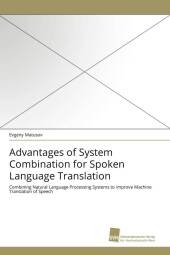 Neuerscheinungen 2010Stand: 2020-01-07 |
Schnellsuche
ISBN/Stichwort/Autor
|
Herderstraße 10
10625 Berlin
Tel.: 030 315 714 16
Fax 030 315 714 14
info@buchspektrum.de |

Evgeny Matusov
Advantages of System Combination for Spoken Language Translation
Combining Natural Language Processing Systems to Improve Machine Translation of Speech
2010. 236 S. 220 mm
Verlag/Jahr: SÜDWESTDEUTSCHER VERLAG FÜR HOCHSCHULSCHRIFTEN 2010
ISBN: 3-8381-2012-4 (3838120124)
Neue ISBN: 978-3-8381-2012-6 (9783838120126)
Preis und Lieferzeit: Bitte klicken
Automatic translation of spoken language is a challenging task that involves several natural language processing (NLP) software modules such as automatic speech recognition (ASR) and machine translation (MT) systems. In recent years, statistical approaches to both ASR and MT were proven to be effective on a large number of translation tasks. Yet the systems involved in speech translation are often developed independently of each other. This work explains how a significant improvement of speech translation quality can be obtained by enhancing the interface between various statistical NLP systems involved in the task of translating human speech. The whole pipeline is considered: ASR, automatic sentence segmentation, machine translation using several systems which take single best or multiple ASR hypotheses as input and employ different translation models, combination of different MT systems. The coupling between the various components is reached through combination of model scores and/or hypotheses as well as through development of new and modifications of existing algorithms to handle ambiguous input or to meet the constraints of the downstream components.
Evgeny Matusov defended his Ph.D. in computer science from RWTHAachen University, Germany in 2009. His research interest ismachine translation of text and speech. He authored andco-authored more than 20 reviewed publications in internationalconferences, two journal publications, and received the ISCA BestStudent Paper Award in 2005.


